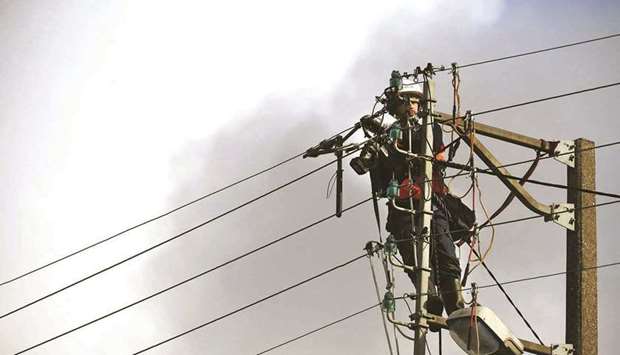Rising LNG imports provide scant relief for Europe power crisis

Reuters/London
Europe’s imports of liquefied natural gas (LNG) are picking up as winter approaches but there is little relief for the region’s power crunch because competition with Asia for supplies is so intense.
Power and gas demand has spiked due to low inventories and surging requirements in Asia and Europe as economies recover from the Covid-19 crisis.
Cold weather in the northern hemisphere has also increased demand for power, prompting buyers to be more active on the spot market to bridge supply gaps and driving LNG prices to record levels.
Wholesale gas markets are reflecting that, with benchmark European TTF values hitting all-time highs.
Asian spot LNG prices hit a record peak of above $56 per million British thermal units (mmBtu) earlier this month.
Prices have since retreated slightly to around $30 per mmBtu, but are still up 500% from last year.
Northwest Europe’s LNG imports over the January-September period were down by 5.5mn tonnes from levels seen a year earlier, but have picked up since the start of the winter gas season which runs from October to March, when there is higher demand.
Competition between Europe and Asia and a spike in global gas prices saw European TTF and Asian JKM LNG benchmark prices chase each other higher, with the latter priced at a premium to TTF, drawing more supply to Asia rather than Europe.
As a result, northwest Europe is unlikely to see a strong flurry of LNG supply to help ease prices.
“Our latest balance calls for net LNG deliveries to Northwest Europe, in Belgium, France, Netherlands and the UK, this winter to average 114mn cubic metres per day, roughly in line with year ago levels of 116mn cubic metres per day,” said Luke Cottell, LNG analyst at S&P Global Platts.
Asia is home to the world’s three biggest LNG buyers, China, Japan and South Korea, who tend to keep buying throughout the winter. European gas storage levels were well below where they should have been at the start of the winter season on October1, pushing European buyers to compete aggressively for spot cargoes.
“Competition from Asia for flexible Atlantic Basin LNG is expected to be robust, with Northwest Europe facing challenges in competing with largely price insensitive Northeast Asian buyers who have continued to procure spot cargoes despite record high JKM,” said Samer Mosis, manager of global LNG analytics at S&P Global Platts.
Usually, when Asian LNG and TTF prices are so closely coupled, US LNG sellers would favour sending cargoes to Europe to save shipping time and costs, said Robert Songer, LNG analyst at commodities intelligence firm ICIS.
But that is not the case this year.
ICIS’s LNG Edge shipping platform shows that China, Japan and South Korea have all imported more US LNG than in any previous year, while Atlantic Basin importers like Spain, France and the UK have all seen smaller portions of US cargoes.
North American LNG exporters have been adding to capacity because of demand in major Asian economies.
US exports of LNG are expected to average 9.7bn cubic feet per day (Bcf/d) this year, 3.2 Bcf/d higher than the 2020 record high of 6.5 Bcf/d.
This year, the United States’ exports of LNG are also expected to exceed its annual pipeline exports of natural gas for the first time, the US Energy Information Administration (EIA) said in a report.
But with the bulk of US exports destined for Asia, Europe’s best hope for significantly boosting supplies may be a mild winter in China, which is hard to predict, analysts said.
“As long as unexpected cold from the La Nina (weather) system doesn’t see China keep outbidding Europe for cargoes, there is certainly some avenues for more gas to land in Europe in the coming months,” said Ryan McKay, commodity strategist at TD Securities.